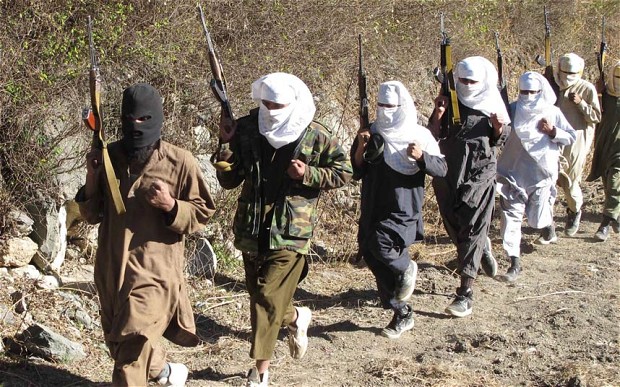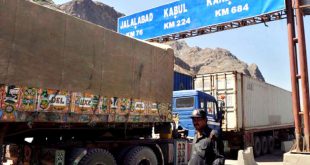Afrasiab Khattak-Religious seminaries have a long history but Taliban (students of the seminaries) emerged as an independent and separate political entity in mid 1990s. They ostensibly rose as a player in Afghan politics to fill the vacuum created by the dramatic decline of former mujahideen in the early 1990s but the Taliban movement bore a clear made-in-Pakistan mark on it for three reasons.
First, almost 95 percent of them were trained in religious seminaries in Pakistan as Afghan refugee children along with locals were attracted by the widening network of seminaries operating in Pakistan, mostly with the financial support of Arab countries. Religious education imparted by the aforementioned seminaries was characterised by the Wahabi school of thought. The students were politicised as these seminaries were run by Pakistani religious political parties who used these institutions as their political base. Religious political parties belonging to the Deobandi School in Pakistan took pride in regarding these Taliban as extension of their political and sectarian influence in Afghanistan. The formation of the “Council for the Defense of Afghanistan” by Pakistani religious political parties to defend the Taliban regime in 2000 was a clear demonstration of this fact.
Second, the Taliban, like their predecessor mujahideen, were launched and facilitated by the Pakistani security establishment to establish hegemony over Afghanistan. In fact the Taliban have been considered an important strategic asset for implementing the policy of “strategic depth” in Afghanistan. This explains prolonged Pakistani support for and investment in the project. In the 1990s Taliban offices functioned openly in all the major cities of Pakistan.
Third, before formally and systematically launching Talibanisation inside Afghanistan, the Taliban led by Molvi Sufi Mohammad, had worked on a pilot project of imposing “Sharia” in the Malakand division of Khyber Pakhtukhwa province in Pakistan. When the Taliban captured Kabul in 1996 and started ruling Afghanistan Talibanisation started gripping FATA. Taliban ascendency in the area increased as their leadership retreated from Afghanistan after the collapse of their regime in Kabul after 9/11. They regrouped on the Pakistani side of the Durand Line and started a new stage of war in Afghanistan in 2003. The TTP though technically a separate entity has enjoyed close ideological and organisational relationship with the main body of the Taliban. The TTP fighters are fighting in Afghanistan along side their Afghan comrades and the TTP also depend on their Afghan counterparts for sanctuaries in the Afghan border areas where Afghan government’s writ is minimal.
There are a number of myths attached with Taliban in the state sponsored narrative over the years as the Taliban became the backbone of Pakistan’s Afghan policy. They are projected as the so-called resistance movement against foreign occupation. Nothing can be further from truth. From their inception in 1994 till 9/11 they fought against Afghans as there was not a single foreign soldier on Afghan soil during that period. They have basically waged war against the Afghan state. The Taliban fought to overthrow the regime led by Professor Burhanuddin Rabbani and Ahmad Shah Masood. They also attacked Gulbadin Hikmatyar’s organisation and other Afghan factions. In fact their links with Al Qaida and their support for OBL turned Afghanistan into a theater for international military conflict.
Similarly to camouflage their mercenary nature Taliban they also projected themselves as “representatives of Pashtuns” against the domination of the Northern Alliance in Afghanistan. This is again a very misleading spin. Talibanisation is first and foremost aimed at decimating historical Pashtun national identity and is also geared towards demonising Pashtuns in regional and international politics. Pashtun culture has been the main victim of the Taliban onslaught. In fact Pashtuns in Afghanistan have suffered the most because of Taliban attacks in terms of loss of life and destruction of infrastructure. It is also hardly a coincidence that Pashtun nationalists in Pakistan have borne the brunt of Taliban’s terrorist attacks in Pakistan. In a similar vein it is claimed that Taliban can’t be defeated in Afghanistan. In fact they are defeated on daily basis in Afghanistan, but their sanctuaries on the east of Durand Line enable them to carry on and launch fresh attacks.
Discussing the Taliban Project here is not meant to deny other factors responsible for war in Afghanistan. It is a fact that Afghanistan has been a victim of the machinations of the imperial “Great Games” and Cold War rivalries. Big powers including the erstwhile Soviet Union, US and European Powers cannot absolve themselves from the responsibility of bloodshed and destruction in Afghanistan during the last decades. But the present stalemate in resolving the conflict in and around Afghanistan is due to Taliban.
In the 2014 Pakistan visit of Dr. Ashraf Ghani Pakistani leadership had promised to facilitate talks between the Afghan government and Taliban. It was also decided that while forging peace with reconcilable elements, both the countries will fight together against those who refuse to enter the peace process. The Taliban have used this engagement to launch a full fledged war against Afghan state. They have owned responsibility for some horrendous terrorist attacks in Afghanistan particularly in Kabul. Afghan public opinion has seriously turned against negotiation with Taliban. Taliban have failed to develop any significant political capital on both sides of the Durand Line due to their undeniable links with terrorist activities. The paradox of Pakistani policy is that it is crushing them in Pakistani territory but supporting them in Afghanistan. It is very difficult for Pakistan to deny responsibility for Taliban activities in a situation where Mr. Sartaj Aziz has formally accepted the presence of Taliban leadership in Pakistan.
Project Taliban, a remnant of Cold War, is a hindrance to peace in Afghanistan. It is the biggest obstacle in establishing normal state to state relations between Pakistan and Afghanistan. It is also the most major source of regional instability in South and Central Asia that threatens the prospects of important regional economic development projects and regional connectivities such as CPEC, TAPI and other initiatives. Pakistan has to take rethink its policy about Project Taliban. It will go a long way in transforming Pakistan into a normal state.
 Afghanistan Times
Afghanistan Times




